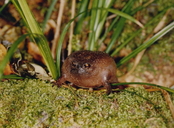|
Breviceps fuscus Hewitt, 1925
Black rain frog | family: Brevicipitidae genus: Breviceps |
 © 2005 Wolfgang Ochojski (1 of 9) |
|
|
|
Description Breviceps fuscus is typically dark brown or nearly black with a slightly lighter ventral surface and no pigmented patterns (Hewett 1925; Channing 2001). Distribution and Habitat Country distribution from AmphibiaWeb's database: South Africa
Life History, Abundance, Activity, and Special Behaviors The breeding season takes place during summer starting in October and lasting at least through February (Branch and Hanekom 1987; Channing 2001). Males call from within burrows, sometimes while guarding eggs, and above ground in vegetation using “a short chirp, 0.2s long, at a dominant frequency of 1.8kHz” (Channing 2001). Yellow eggs are laid within burrows with 15 mm openings about 30 – 40 mm deep in spherical nests about 30 mm across. Each nest consists of approximately 42 - 43 eggs that are 5 mm in diameter within 8 mm capsules. The nest is covered with a layer of 25 - 30 empty eggs cases on top (Channing 2001). Males continue to guard eggs in the nest while calling, until direct-developing froglets hatch (Channing 2001; Minter et al. 2004). This species is eaten by the local bushpig Potamochoerus porcus (Channing 2001), and the colubrid snake Crotaphopeltis hotamboeia (Keogh et al. 2000). Trends and Threats Possible reasons for amphibian decline General habitat alteration and loss Comments The species epithet "fuscus" refers to the frog’s dark coloration (Channing 2001).
References
Branch, W. R. and Hanekom, N. (1987). The herpetofauna of the Tsiktsikamma Coastal and Forest National Parks. Koedoe, 30, 49-60. Carruthers, V. C. and Robinson, G. A. (1977). ''Notes on Amphibia in the Tsiktsikamma National Parks.'' Koedoe, 20, 115-123. Channing, A. (2001). Amphibians of Central and Southern Africa. Cornell University Press, Ithaca, New York. Hewett, J. (1925). ''Descriptions of three new toads belonging to the genus Breviceps Merrem.'' Annals of the Natal Museum, 5, 189-194. Keogh, S. J., Branch, W. R., and Shine, R. (2000). ''Feeding ecology, reproduction and sexual dimorphism in the colubrid snake Crotaphopeltis hotamboeia in southern Africa.'' African Journal of Herpetology, 49, 129-137. Minter, L., Channing, A., Harrison, J. (2004). Breviceps fuscus. In: IUCN 2012. IUCN Red List of Threatened Species. Version 2012.2. Species Account Citation: AmphibiaWeb 2013 Breviceps fuscus: Black rain frog <https://amphibiaweb.org/species/2373> University of California, Berkeley, CA, USA. Accessed Jun 4, 2025.
Citation: AmphibiaWeb. 2025. <https://amphibiaweb.org> University of California, Berkeley, CA, USA. Accessed 4 Jun 2025.
AmphibiaWeb's policy on data use.
|


 Map of Life
Map of Life